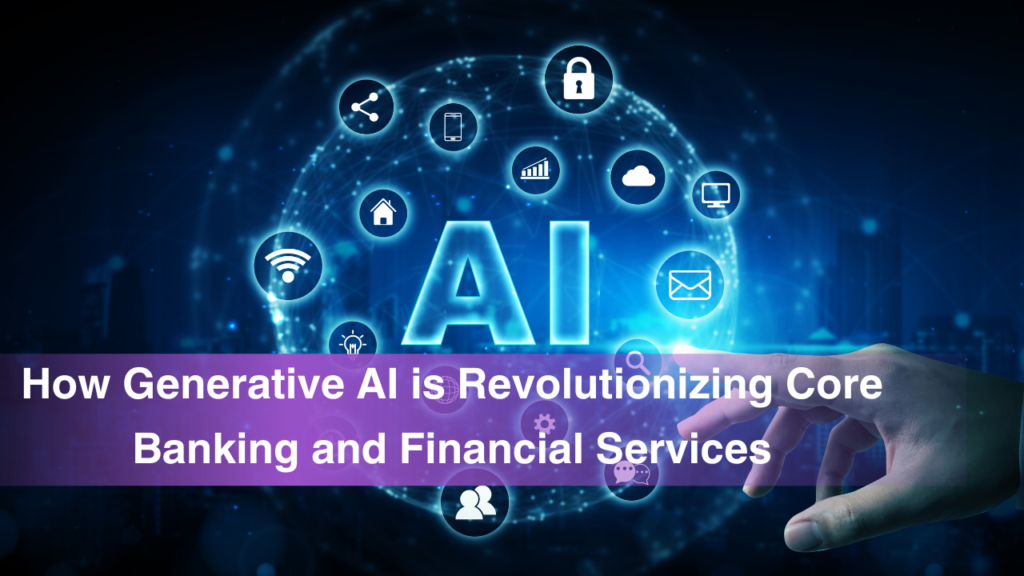The financial services industry is at a tipping point. Rising customer expectations, rapidly evolving technologies, and mounting operational challenges are pushing banks and financial institutions to rethink their strategies. Enter Generative AI—a breakthrough technology that’s rewriting the rules of core banking and financial services.
From automating mundane processes to enhancing customer engagement, Generative AI is empowering banks to achieve unprecedented levels of efficiency, innovation, and customer satisfaction. This blog dives deep into how Generative AI is transforming the financial landscape, providing actionable insights and real-world examples along the way. Let’s explore how this game-changing technology is reshaping the future of banking.
- Solving Skill Shortages with Automated Code Development
The Problem: The financial industry faces a persistent shortage of skilled developers, making it difficult to manage and modernize complex core banking systems.
Generative AI to the Rescue: Tools like OpenAI’s Codex can generate, debug, and optimize code at lightning speed. This not only accelerates software development but also reduces reliance on specialized talent, allowing teams to focus on higher-value tasks.
Real-Life Example: JPMorgan Chase leverages AI-powered code automation tools to streamline software updates and reduce development time. These tools enable developers to focus on innovation rather than routine coding tasks, improving productivity across the board.
- Reducing System Downtime with Predictive Maintenance
The Problem: Operational downtime can result in significant financial losses and erode customer trust.
Generative AI to the Rescue: Predictive maintenance tools powered by AI analyze vast amounts of data to anticipate system failures before they occur. This proactive approach reduces downtime, ensuring smoother operations.
Real-Life Example: Bank of America uses predictive AI to monitor its IT infrastructure. This has led to a 30% reduction in downtime, delivering uninterrupted banking services and boosting customer satisfaction.
- Streamlining Risk Management and Compliance
The Problem: Financial institutions face ever-evolving regulatory requirements and must manage risks effectively while maintaining compliance.
Generative AI to the Rescue: AI-powered tools automate the monitoring of regulatory changes, assess compliance in real-time, and flag potential risks. Generative AI makes it easier to adapt to new regulations while minimizing risks.
Real-Life Example: HSBC relies on AI-driven compliance systems to monitor transactions and regulatory updates. These systems enable HSBC to stay ahead of compliance requirements and address risks proactively.
- Delivering Personalized Customer Experiences
The Problem: In today’s competitive market, offering personalized customer experiences isn’t optional—it’s a necessity.
Generative AI to the Rescue: AI-powered chatbots and virtual assistants provide instant, tailored customer support, while AI-driven analytics offer personalized financial advice and product recommendations.
Real-Life Example: Capital One’s virtual assistant, Eno, uses AI to handle customer queries, provide personalized tips, and assist with transactions. This reduces response times, improves satisfaction, and enhances the overall banking experience.
- Modernizing Legacy Systems for the Future
The Problem: Legacy systems often hinder innovation and are costly to maintain.
Generative AI to the Rescue: AI tools automate the migration of legacy systems to modern platforms, optimize outdated code, and improve scalability and security.
Real-Life Example: Citibank utilized AI to modernize its core banking applications by migrating them to cloud-based systems. This move enhanced scalability and reduced operational costs, allowing Citibank to focus on delivering better services to its customers.
- Improving Employee Onboarding and Experience
The Problem: Lengthy onboarding processes and disjointed employee experiences can affect productivity and retention.
Generative AI to the Rescue: Generative AI automates onboarding tasks like training, paperwork, and orientation while creating personalized learning paths for employees.
Real-Life Example: Goldman Sachs employs AI-powered onboarding systems that reduce administrative overhead, streamline training, and improve the integration process for new hires. This has led to faster onboarding times and increased employee satisfaction.
- Boosting Business Efficiency Across the Board
The Problem: Inefficiencies in business processes can drive up costs and slow down operations.
Generative AI to the Rescue: Generative AI automates routine processes, optimizes workflows, and provides data-driven insights to improve decision-making and operational efficiency.
Real-Life Example: American Express uses AI to enhance fraud detection and transaction processing. By automating these workflows, they’ve reduced operational costs and improved real-time fraud prevention, ensuring a smoother customer experience.

